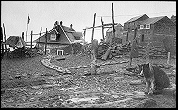Unique Kugeri Stands on Little Diomede Island - Part 2

The ceiling of the house slopes from the main roof support beam, giving a height of 1.9 m for the east wall and 1.8 m for the west wall. A skylight is above the entry in the west-sloping section of the ceiling. Formerly covered with a translucent sheet of sewn strips of seal or walrus intestine, today the skylight is furnished with a double layer of sheet plastic and a protective framework to discourage dogs and people from venturing too close.
Interior walls are made of vertical planks and plywood. A beam support rises in each corner from beneath the floor beams that run around the interior walls and prevent the wallboards from sagging inward. In 1977 the walls and most of the ceiling were painted

flat white to cover the accumulation of soot from the seal oil burned over the years.
The most conspicuous furnishings of the house are the benches along the four walls.
Made of wood that is very old and worn, they may be the oldest parts of the structure.
Two stands for seal oil lamps and two drying racks remain in the house and along with
the benches, complete the original furnishings.
Outside the interior walls is a layer of sod insulation about .25 m thick. Sod is
also used as insulation above the house ceiling and tunnel. Boards and corrugated
iron sheeting are on top of the sod to direct rain and melting snow away from the
interior. Stones are plied outside the sod along the walls.

Dating of the kugeri is uncertain and its original builder is unknown. The house has
changed hands at least three times since 1900. John Lyapana said it was present at
least as early as the 1920s; he can remember there being four such structures on the
island then. The house has probably been rebuilt several times on top of the original
structure.
Before trading and purchase of commercial construction materials became a frequent
practice, the people of Little Diomede used only local materials. But carpentry tools,
nails, and sized, precut lumber were quickly adopted as they became available.
Although the old houses were well built and most of the water from rain and snowmelt
is directed away from them, the maritime climate of the Diomede Islands makes some
organic decomposition inevitable. Coupled with daily wear and tear, this makes replacement
of parts necessary from time to time. Before precut lumber was used, wooden parts
could be refitted only as new driftwood was located and worked to size.
By the time the Little Diomede kugeri was refurbished in 1945, the old wallboards
and ceiling were replaced with wooden planks from Seattle and the ceiling was lowered.
The same basic design and construction techniques were applied in the replacement
project, with planks substituted for split driftwood logs and poles for whale jawbones.
No nails were used in house construction in the early 1900s, but they were used extensively
in 1945. The most recent significant changes were made to the kugeri in 1977, when
the seal oil lamps used for light and heat were replaced with a fuel oil stove and
electric lights.
Because a kugeri was larger and could seat more people, it was a focal point of social
and cultural activity. Here the people could gather nightly for story telling and
dancing. Ceremonies were often centered here; for example, when a whale was killed,
the captain of the boat crew would borrow a kugeri (if he did not own one) and live
in it with his family for about six weeks. During this time he held feasts and dances
which constituted an important part of the Little Diomede winter activity.
The doctor (shaman) also performed his services in the kugeri, summoning spirit helpers
during bad weather, food shortages and when illness required a cure. Although the
house, both igloo and kugeri, was the center of all types of activity throughout the
seasonal cycle, the kugeri was a structure of special importance for the community.
The significance of this Little Diomede kugeri rests on three major factors: it is
a unique type among the semi subterranean structures on the island and is the last
remaining example of its type; it is one of few remaining examples in arctic Alaska
of a style of architecture that, with locally available materials, protected its inhabitants
from one of the most severe environments in the world. Fewer still are in such excellent
condition; finally, it is a tangible link with the past way of life of the islanders.
Its dynamic mix of ancient and modern elements mirrors their life today.
In the accompanying illustration, the terms for the dwelling's parts are given, as
much as possible, as the people of Ignaluk would give them. However, the Little Diomede
dialect is imperfectly known, so these translations are only the best transcriptions
possible without a more extensive linguistic analysis.
Larger Cross Section Image of Kugeri Interior Reprinted from: Now in the North, Volume 12, Number 2. May 1982. University of Alaska.
